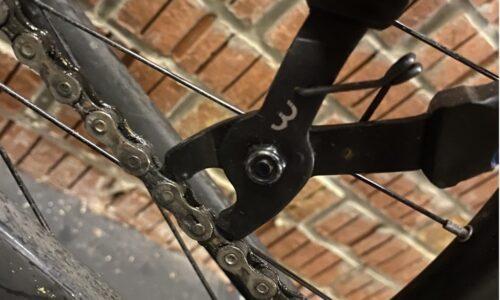Both Shimano and SRAM offer a wide range of groupsets. Both these brands have nailed how to make quality components and parts to accompany a frame and tires to make a bicycle that is reliable and versatile from low to high end.
The SRAM Apex and Shimano 105 are reliable, but which one should you choose for your next upgrade.
It can feel like you are splitting hairs, but the groupset you choose has a considerable impact on your ride, so it is worth doing your research into which one will best suit your needs and budget.
Before we dive into which groupset you should choose, here is a quick summary of each component that makes up the SRAM Apex and Shimano 105 groupsets.
SRAM Apex Groupset
Shifters


SRAM uses the Double-tap system. You push the lever behind the brake hard (two clicks) for a higher gear and not so hard (to drop down a gear). The shifters are responsive and as soon as you get used to the mechanism, gear changing is relatively instantaneous.
Chainset/Crankset


SRAM’s real USP is their gearing ratios that lead to fewer cogs but offer the same versatility that you get from the likes of Shimano. For example, you can get a 1×11 option, with only one cog on the front; you would think that it would not suit a road bike.
However, they have managed to nail the gearing ratio with the extra-large cassette at the back. You still have the more traditional gearing options available of 53/39, 50/34 and 48/35
Front and Rear Derailleur
SRAM’s unique WiFLi (Wider range than a triple crankset, with a Faster shift and Lighter overall weight) helps minimize weight and keep the whole groupset more streamlined. However, you do not see any great weight saving on the Apex groupset compared to other groupsets in the same price range.
Both derailleurs perform dutifully and work well across the smaller range of gears. The rear derailleur comes in a mid or long version, depending on the gearing.
Brakes


Smooth, reliable and straightforward. Far from the lightest or most responsive on the market, the Apex brake calipers do what they are supposed to, reliably.
They are also large enough to fit up to 28mm tires, or even a thinner tire with a slim mudguard/fender.
Shimano 105 Groupset
Shifters


The 105 shifters are very similar to the Dura-Ace and Ultegra shifters, adding to the groupsets high-quality look and feel. With the flattened top and lightly textured grip, the hoods feel comfortable and you have plenty of grip, even in wet weather or without gloves. They come with the classic Dual control levers and give responsive braking and instant gear changes.
Chainset/Crankset
The 105 cranks are available in 53/39t, 52/36t and 50/34t chainring options. The 105 chainset uses Shimano’s Hollowtech chainset, resulting in a wider crank arm, but it is lighter. Usually found on the Dura-Ace, this has a significant impact on the overall weight of the 105 groupset.
Somehow they have managed this without losing any stiffness, meaning that the power you put down into the pedals gets instantly transferred to the wheels.
Front and Rear Derailleur

The front derailleur on the 105 groupset is more compact, quieter and more responsive than lower-end groupsets. It has a polymer insert on the back of the cage, which dampens any noise caused by the chain rubbing if the alignment is slightly out or while in extreme gears.
The rear derailleur has been taken from Shimano’s previous mountain bike groupsets. They have made the rear mech more compact without causing any chain grating or issues changing gear. Being more compact helps the bike look sleek and helps keep it protected in a crash.
Brake
You have the option of the standard dual-pivot calipers or the direct-mount brakes. The direct-mount brakes are usually found on the higher end groupsets. You can easily fit tires up to 28cc and get responsive and swift braking with both sets of brakes.
Verdict
Whichever brand you choose, I highly recommend you sticking to that across all your bikes. If you run SRAM on your gravel bike and Shimano on your road bike, the different methods of changing gear can cause unnecessary confusion as you try to remember which shifter system you are riding.
Shimano has had plenty of experience designing and refining their components, especially for road bikes. As a result, they are ahead of the competition in terms of innovation and ease of use.
The Shimano 105 groupset benefits significantly from the near-perfect parts that used to be included in the highest-end components on the market on the Ultegra and Dura-ace groupsets. What was once the best the money could buy is now available at much more affordable prices on the 105 groupset.
Although the Shimano 105 groupset is slightly more expensive than SRAMS Apex, not only is it lighter, but it also feels better quality. From the textured hoods to the quieter, more efficient derailleurs, the 105 groupset is the best on the market for value for money.
It could easily hold its own on lightweight carbon bikes and not look out of place or have a detrimental effect on performance. In comparison, SRAMs Apex has a litter further to go.
Maybe in the coming years, the Apex will benefit from the obsolete parts from its more expensive Rival or Force groupsets.
I’ve spent way more time in the bike trade than anyone should reasonably want to. In that time I’ve wanted to make cycling jargon and marketing easier to cut through to help people get the bike of their dreams.
When I’m not writing about bikes, I can be seen out bikepacking on single speed bikes or teaching kids how to ride.






